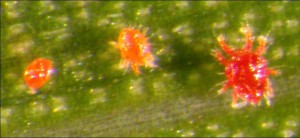 Countless tiny little red palm mites move across the underside of palm fronds, and on bananas, heliconias and gingers. The red palm mite cycle is approximately 23-28 days. All palm species should be considered potential hosts for this mite. Coconuts appear to be the most commonly infested palm.
Countless tiny little red palm mites move across the underside of palm fronds, and on bananas, heliconias and gingers. The red palm mite cycle is approximately 23-28 days. All palm species should be considered potential hosts for this mite. Coconuts appear to be the most commonly infested palm.

Damage: Young coconut palms appear to be the most severely injured. Damage symptoms include leaf yellowing or yellow spots which eventually become reddish-brown colored and then begin to rot. The symptoms caused by heavy infestation of the red palm mite could be confused with palm nutritional deficiencies(potassium)or palm disease, such as lethal yellowing.
Management: If necessary, prune off the most heavily infested plant parts, double bag and dispose of before moving it. Do not move infested plants or plant material as it facilitates spread of this pest to unaffected areas. Potential predators have been identified for red palm mite control; however more work is necessary to determine their impact. Insecticidal soaps and horticultural oils can be effective but thorough coverage is necessary and may be difficult to achieve.
This article is an abbreviated version of Red Palm Mite by Dr. Catharine Mannion
Weblinks:
http://edis.ifas.ufl.edu/in711
http://www.freshfromflorida.com/pi/pest-alerts/raoiella-indica.html
http://entomology.ifas.ufl.edu/creatures/orn/palms/red_palm_mite.htm
These links were current as of May, 2013.
Photo Credit: UF/IFAS
Florida Department of Agriculture and Consumer Services
 0
0
